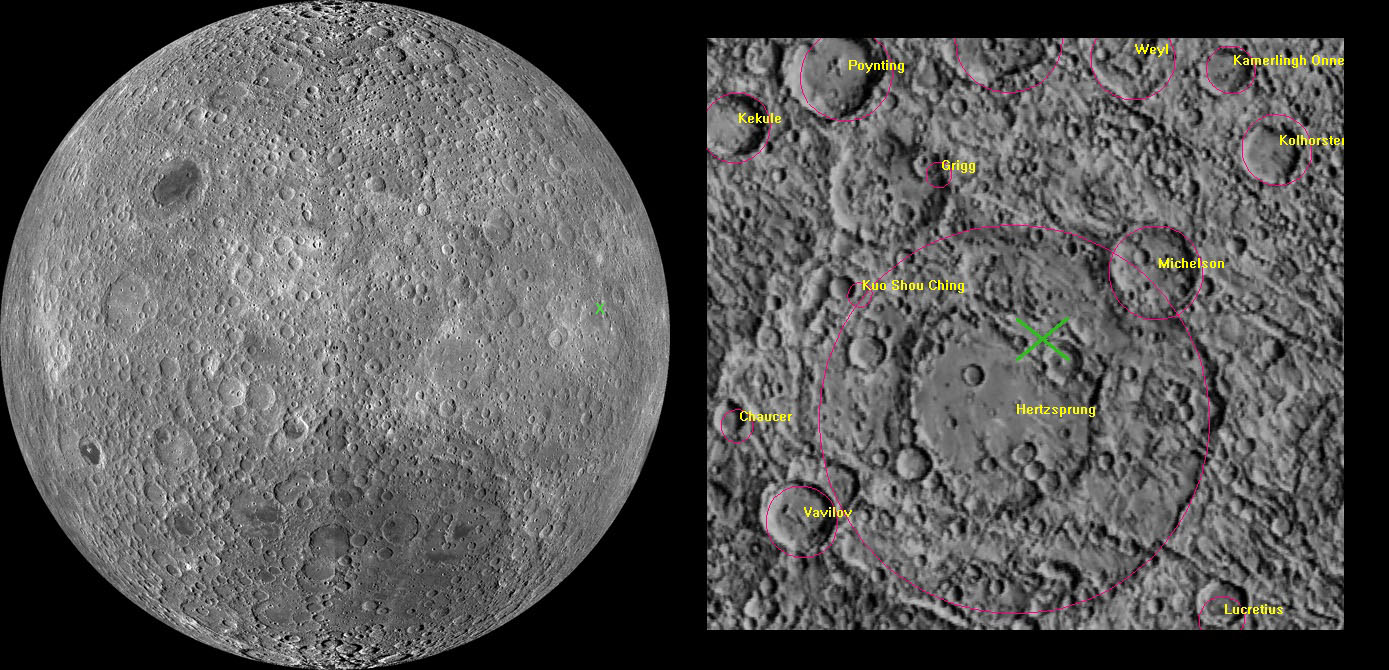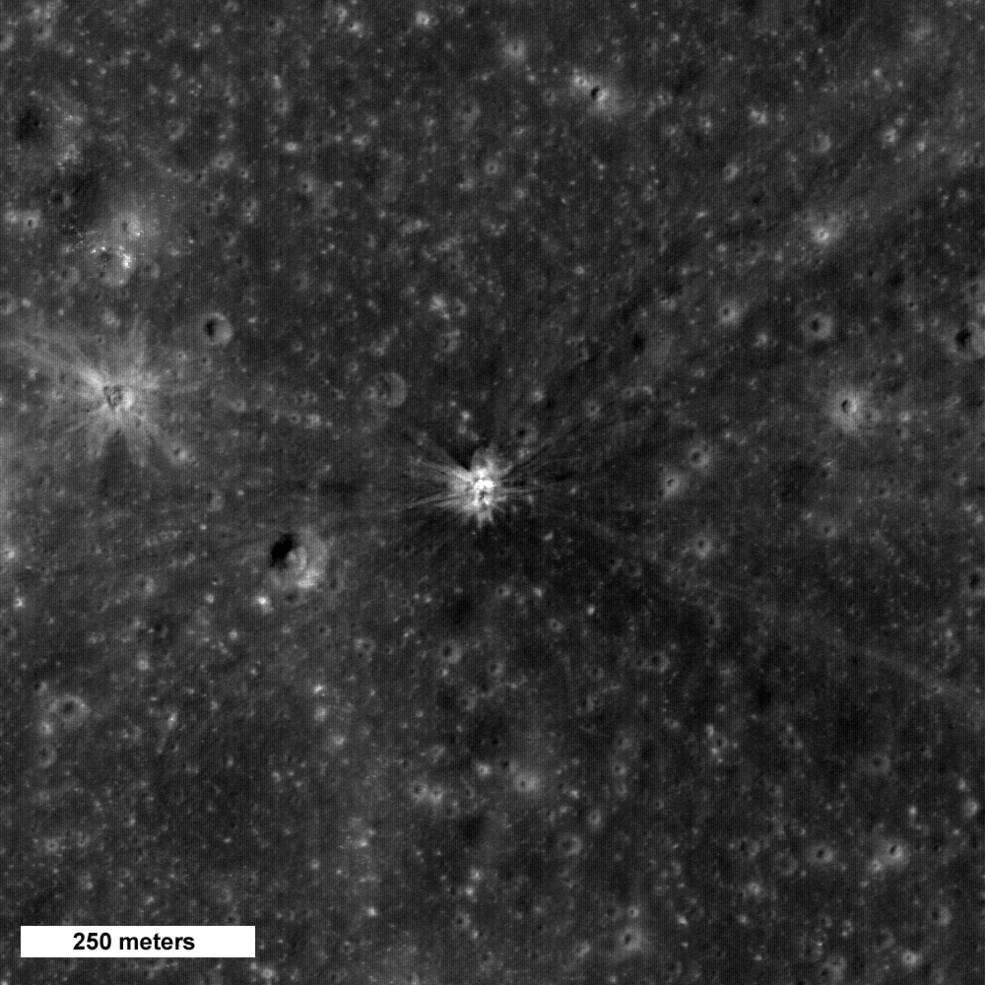The booster previously identified as SpaceX hardware turns out to be from the Chang’e 5-T1 mission. The timing and site of the impact remain the same.
Updates:
In an unexpected twist, China's Ministry of Foreign Affairs claims that the wayward booster about to hit the lunar farside isn't theirs. Bill Gray at Project Pluto has responded, addressing questions and noting a likely mix-up between the 2020 Chang'e 5 mission and the lesser known Chang'e 5-T1 precursor. Certainly, the saga highlights the need for better tracking of objects in high-Earth Orbit.

Lunar farside: NASA / Goddard / Arizona State University; inset: Bill Gray / Project Pluto
When it comes to old space debris, there are lots of lost, forgotten, and even misidentified objects out there. This was highlighted when observers realized that the object set to hit the lunar farside on March 4th is not, in fact, the SpaceX upper stage used to launch the DSCOVR mission, but instead a discarded segment of a Chinese lunar mission, Change'e 5-T1.
Bill Gray at Project Pluto first alerted the astronomical community about the possibility of the impact earlier this month, and he released the correction last weekend. Jon Giorgini, who works with the Jet Propulsion Laboratory's Solar System Dynamics Group, had raised doubt concerning the object’s identity.
“Jon pointed out that the DSCOVR spacecraft’s trajectory did not go particularly close to the Moon,” says Gray in a recent post, referring to a pass on February 15, 2015, two days after DSCOVR launched. “It would be strange if the second stage went past the Moon, while DSCOVR was in another part of the sky.”
The mix-up occurred because something bright, found by the Catalina Sky Survey in 2015 and dubbed WE0913A, was in a temporary orbit around Earth at the time and passed the Moon that February 15th. Gray noted at the time that the object might have been related to the launch, but the identification was far from definitive at the time. “I didn’t have a trajectory for DSCOVR at the time, and the lunar flyby seemed quite plausible (spacecraft often use a lunar flyby to adjust their orbits),” he explains.
After receiving Giorgini's email, though, Gray went on a search to find other candidates. “It had to have been launched not long before March 2015, in a high orbit going past the Moon,” he writes. “The preceding candidate launch was the Chang'e 5-T1 mission, launched at 18:00 UTC on 2014 October 23. Its booster was (we thought) never seen.”
That would make the mystery object the third stage Long March 3C booster (COSPAR ID 2014-065B), which launched the Chang’e 5-T1 mission and made a lunar flyby four days after launch.

Gianluca Masi / Virtual Telescope Project
The spacecraft was sent on a free-return trajectory out past the Moon and returned to Earth on October 31, 2014 over Siziwang Banner, Inner Mongolia. Its primary mision was to test return-capsule technology ahead of the full sample return mission, Chang’e 5, that China carried out successfully in December 2020.

CALT / CASC
Despite the case of mistaken identity, the object's impact time (12:26 UT/7:26 a.m. EST on March 4th) and location (near Hertzsprung Crater on the lunar farside) remain the same. Earthbound observers and orbiters won’t see it occur, but NASA’s Lunar Reconnaissance Orbiter or India’s Chandrayaan 2 orbiter, both in low orbits, could see the results after the 2,800-kilogram (6,100-pound) stage hits the Moon.

NASA / LRO
In addition to Gray's calculations, two other factors helped cinch the identity of the mystery body. First, an amateur radio CubeSat, the Manfred Memorial Moon Mission built by Luxembourg company LuxSpace, was attached to the upper stage and operated until late 2014. The orbital elements for that mission are a good match to the object itself.
Second, University of Arizona students took the object's spectrum to determine its construction. "We took a spectrum (which can reveal the material makeup of an object) and compared it with Chinese and SpaceX rockets of similar types, and it matches the Chinese rocket," says Vishnu Reddy (University of Arizona), who led the observations with his students.
So the rocket about to hit the Moon, it turns out, is not the one we thought it was. This (an honest mistake) just emphasizes the problem with lack of proper tracking of these deep space objects. https://t.co/JXKpUmEC2X
— Jonathan McDowell (@planet4589) February 13, 2022
Space debris — both its production and tracking it — is a growing problem in both low- and high-Earth orbit. Still, there's a bright side: This event does make Luxembourg the seventh country or agency (behind the Soviet Union, the U.S., China, ESA, India and Israel) to reach the lunar surface.
 0
0









Comments
You must be logged in to post a comment.